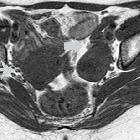granulosa cell tumor of the ovary












 nicht verwechseln mit: Granularzelltumor
nicht verwechseln mit: GranularzelltumorGranulosa cell tumors of the ovary are a type of sex cord / stromal ovarian tumor.
Epidemiology
Sex cord-stromal tumors represent approximately 8% of all ovarian tumors and are believed to arise from and/or to contain combinations of the sex cord and stromal components of the developing gonad. Granulosa cell tumors of the ovary comprise a distinct subset of ovarian cancers that account for approximately 5% of all ovarian malignancies .
Clinical presentation
Patients may present with nonspecific symptoms such as abdominal pain, distention, or bloating. In a majority of cases, there may be hormonal manifestations due to estrogen activity of the tumor .
Pathology
They are thought to arise from normal proliferating granulosa cells of the late preovulatory follicle and exhibit many morphological and biochemical features of these cells. GCT is distinct from other ovarian carcinomas in their hormonal activity; their ability to secrete estrogen, inhibin, and Müllerian inhibiting substance accounts for some of the clinical manifestations of the disease and also provides useful tumor markers for disease surveillance .
Associations
- the hyperoestrogenemia may produce
- endometrial hyperplasia
- endometrial polyps
- endometrial carcinoma: associated in ~15% (range 3-25%) of cases
- Maffucci syndrome: with juvenile granulosa cell tumor
Subtypes
It can be divided into two broad subtypes:
- adult granulosa cell tumor of the ovary: much more common and accounts for ~95% of cases
- juvenile granulosa cell tumor of the ovary
Radiographic features
They are slow-growing, predominantly solid masses with variable amounts of cystic change and intratumoral hemorrhage. Bilaterality is rare.
Oestrogenic effects on the uterus may manifest as uterine enlargement or as endometrial thickening or hemorrhage.
Ultrasound
- appearance varies widely: may appear anywhere from a solid mass to a multiloculated solid and cystic mass, to a purely cystic lesion
- varying degrees of hemorrhage or fibrosis
- less likely to have intracystic papillary projections than epithelial ovarian tumors
CT
The CT appearance of a granulosa cell tumor is usually that of a large, well-defined low-attenuation ovarian mass.
Treatment and prognosis
It is suggested that stage I granulosa cell tumors should go for fertility-sparing surgery, unilateral salpingo-oophorectomy appears to be the most appropriate course of action.
See also
Siehe auch:
- endometrial polyp
- Neoplasien des Ovars
- endometrial hyperplasia
- adulter Granulosazelltumor des Ovars
- Endometriumkarzinom
- Maffucci-Syndrom
- Granulosazelltumor
- juveniler Granulosazelltumor des Ovars
und weiter:

 Assoziationen und Differentialdiagnosen zu Granulosazelltumor des Ovars:
Assoziationen und Differentialdiagnosen zu Granulosazelltumor des Ovars:





